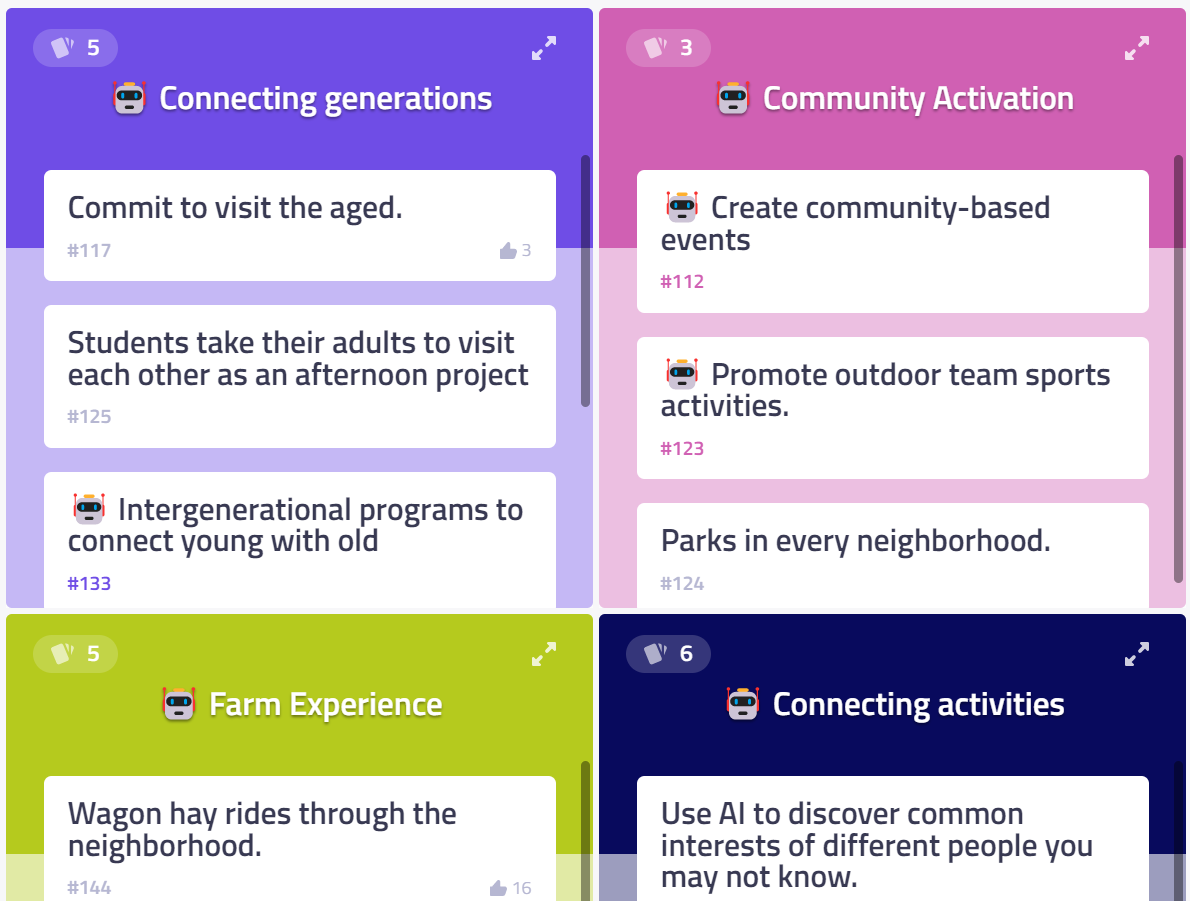I just wrapped up my fourth AI-enhanced workshop. I’ve also invested loads of time fine-tuning Stormz's AI features (now available to all). During most of these sessions, I tested our AI Clustering function. It's fantastic, but I can assure you, clustering isn't just about pressing the AI magic button!
In this post, I'll reveal how relying solely on AI Clustering can make us facilitators a bit lax, ultimately proving counterproductive.
Then, I'll introduce my new, powerful clustering approach that combines AI and manual clustering. Note that this approach should work with any serious AI-powered facilitation application (like Stormz or Miro).
Get ready to experience the best of both worlds!
What is Idea Clustering?
In a nutshell, idea clustering is the process of categorizing ideas into related groups after they've been generated.
It's commonly used by facilitators in a collaborative workshop after a divergence phase (ie. brainstorming and other idea generation techniques.
It has gained immense popularity since facilitators started using Post-it notes. The Post-it's ability to stick, unstick, and restick has been a game-changer, and this concept now lives on in digital platforms like Stormz and its dymamic board, as well as digital whiteboards such as Mural and Miro.
Why Bother with Clustering?
Before exploring AI clustering, let's discuss why clustering matters. Usually done after a divergence phase (i.e., idea generation), clustering serves several key purposes:
- Clarity: It helps participants process and understand the many ideas generated.
- Ownership: Clustering makes sure everyone engages with ALL content, not just their own ideas.
- Diversity: Clustering can reveal any missing or underdeveloped areas within the idea set, allowing teams to generate even more ideas.
- Creativity: Clustering sparks surprising idea combinations, resulting in innovative solutions.
Don't overlook all of these points…
While clarity is obvious, junior facilitators often forget the vital roles of ownership, divergence, and creative collisions in clustering. Too bad, these are essential to unlocking the full potential of idea clustering.
The Limitations of AI-Powered Clustering
Alright, let's return to our main topic: AI-powered clustering.
But hold on! There's a catch. What AI clustering does is grouping ideas based on semantic similarities.
In short, semantic grouping works well for clarity, but it falls short when it comes to ownership and creativity.
Here's the potential disaster I see looming: Facilitators who rely solely on AI semantic clustering might end up disappointed and blame brainstorming, AI features, or even Stormz (which would be even worse!).
The Solution: A Blended AI + Manual Clustering Process
Now that we're aware of the limitations, let's stick to fundamental principles and develop a new clustering process that combines AI capabilities with human input:
1/ Idea generation steps (out of scope)
Imagine you have 100+ ideas. It's quite challenging to grasp the various perspectives and make sense of it all.
Option. Before you start, you can set aside the most crazy ideas. You will see why in step 5.
2/ Group by similarities with AI
In just a few seconds, you get several auto-labeled clusters containing semantically related ideas. This step provides clarity, helping participants easily understand what's been generated.

3/ Clean the board
- Collaboratively remove duplicates,
- Merge similar ideas (cautiously! At this stage, we still want ideas to be specific and focused),
- Participants can ask clarification questions and reformulate ideas as needed,
- If an AI-generated cluster is too large, feel free to split it into smaller clusters. You can use AI to do this more quickly.
Now, you have a clear board with increased ownership from participants who've become familiar with all the directions explored.
4/ Generate more ideas
With the board cleared, participants can identify sparse clusters or notice missing topics, prompting new idea generation.
Create new clusters on the fly:
- Encourage participants to come up with more ideas,
- If needed, you can also ask the AI to generate additional ideas.
Repeat steps 3 and 4 as necessary. By the end, you should achieve greater clarity, more diversity, and increased ownership.
5/ Provoke disruptive associations
Now comes the most valuable, yet challenging, step.
- Create new, surprising clusters with opposing ideas and reformulate labels to uncover hidden insights.
- Duplicate ideas across different clusters or merge them with other ideas to create disruptive concepts.
- If you've set aside wild ideas (see the option in step 1), now is the time to create unconventional associations.
- You can also use a random insight generator or AI to create these unique connections.
Voilà! You've successfully completed a state-of-the-art clustering process. Your board will not only be understood and owned by participants, but also filled with insightful and disruptive ideas. Ready to dive into the convergence phase!
Craving more? Feel free to subscribe to my newsletter, where I both share simple tips for facilitators and in-depth insights. Don't forget to follow me on LinkedIn and on Twitter as well!
